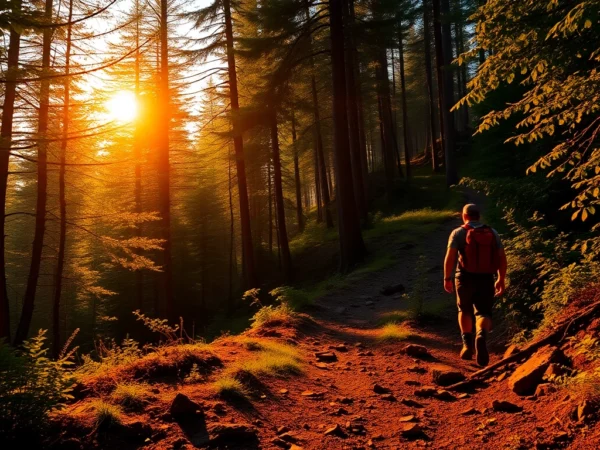Master the Art of Hiking: Essential Tips for a Safe and Enjoyable Trail Experience
Understanding the Basics of Hiking and Its Benefits
Embarking on a hike opens the door to an immersive experience in nature, offering both physical and mental rejuvenation. Unlike casual walks on paved paths, hiking involves traversing diverse terrains—mountains, forests, rocky trails—that challenges both your body and mind. It is a time-honored outdoor activity celebrated across cultures and centuries, dating back to explorers and early settlers who relied on walking as their primary means of transportation and exploration. Today, hiking remains one of the most accessible and rewarding ways to connect with nature, improve health, and find mental clarity. This comprehensive guide delves deeply into what makes hiking a vital outdoor pursuit, the types of hikes suitable for different levels, and the profound benefits it provides.
Defining a hike and differentiating from a walk
Understanding the distinction between a hike and a walk is foundational to appreciating the depth of outdoor exploration. A walk generally refers to a gentle, leisurely stroll on flat, well-maintained surfaces such as sidewalks, park pathways, or urban trails. It’s primarily for relaxation, commuting, or casual exercise. In contrast, a hike involves venturing into more rugged, varied, and often challenging terrains—mountain trails, forest paths, rocky inclines—that require greater physical effort and navigational skills. According to Merriam-Webster, a hike is “to go on a hike,” emphasizing the element of a purposeful, often strenuous walk through wilderness areas. This activity demands proper preparation, skills, and respect for nature, making it a more intense, rewarding experience than a simple stroll.
Health and mental wellness benefits of hiking
Hiking is renowned for its multifaceted health benefits, spanning cardiovascular health, muscular strength, flexibility, and mental well-being. Regular hikes help reduce risks associated with sedentary lifestyles, such as obesity, heart disease, and diabetes. For example, studies indicate that engaging in outdoor physical activities like hiking can lower blood pressure and improve blood circulation. Beyond physical gains, hiking significantly benefits mental health—reducing stress, anxiety, and depression. The immersive experience of nature releases endorphins, fostering feelings of happiness and tranquility. Additionally, hiking boosts cognitive function by encouraging mindfulness and providing opportunities for reflection away from digital distractions. Scientific research consistently highlights that time spent in natural environments accelerates recovery from mental fatigue and enhances mood, making hiking an ideal activity for holistic health.
Types of hikes: casual, adventure, and wilderness
Hiking caters to a spectrum of preferences and skill levels, classified into various types:
- Casual Hikes: These are beginner-friendly, short-distance hikes on well-marked, flat or gently rolling trails. They are perfect for families, beginners, or those seeking relaxation and scenic views without strenuous effort. Examples include forest strolls or lakeside paths.
- Adventure Hikes: Slightly more challenging, adventure hikes involve moderate elevation changes, uneven terrain, or scenic routes that push limits while remaining accessible. They often include features like creek crossings or minimal elevation gains, suitable for casual hikers seeking excitement.
- Wilderness or Expedition Hikes: Designed for experienced hikers, these involve remote, rugged trails—mountain traverses, multi-day backpacking trips, or treks through protected wilderness. Safety, proper planning, and specialized gear are essential for wilderness hikes, which provide unparalleled solitude and connection with nature.
Planning Your Hike: Preparation and Safety
Choosing the right trail and route planning
Effective planning is crucial to a successful hike. Begin by assessing your fitness level, experience, and the hike’s difficulty. Utilize reliable resources such as topographic maps, trail guides, and local parks information to select trails that align with your skill set. For adventurous hikes, consider route duration, elevation gain, and potential hazards. Modern tools like GPS devices and hiking apps (e.g., AllTrails, Gaia GPS) facilitate accurate navigation and trail reviews, reducing the risk of getting lost. It’s advisable to familiarize yourself with your chosen route beforehand, noting landmarks, water sources, and escape routes. Inadequate planning can lead to safety risks, so always have a backup plan and inform a trusted person about your itinerary.
Essential gear and supplies for hikers
Packing the right gear ensures comfort, safety, and preparedness. Key items include:
- Footwear: Durable, well-fitted hiking shoes or boots with good traction to handle varied terrains.
- Clothing: Layered clothing suited to weather conditions, including moisture-wicking base layers, insulating mid-layers, and waterproof jackets.
- Navigation tools: Maps, compass, or GPS devices.
- Hydration: Sufficient water supply and a portable water filter or purification tablets.
- Food: Energy-dense snacks (nuts, trail mix, energy bars).
- First aid kit: Basic supplies for minor injuries, insect repellent, sunscreen.
- Lighting: Headlamp or flashlight, especially for longer or late-day hikes.
- Extras: Emergency blanket, multi-tool, whistle, and trash bags to adhere to Leave No Trace principles.
Assessing weather conditions and safety precautions
Weather can dramatically impact hiking safety. Always check local forecasts before setting out. Sudden storms, high winds, or extreme temperatures pose risks. If weather conditions deteriorate—thunderstorms, snowfall, or excessive heat—consider postponing or modifying your plans. Dress appropriately, monitor environmental cues (like darkening skies or rapidly changing temperatures), and familiarize yourself with signs of hypothermia or heat exhaustion. Carry necessary gear such as rain protection or sun hats, and ensure your mobile device has a reliable signal or carry emergency communication devices. Remember, safety is paramount: abandon your hike if conditions become unsafe and always have a contingency plan.
Executing a Successful Hike: Techniques and Tips
Proper hiking techniques for different terrains
Adapting your technique to terrain is essential for efficiency and injury prevention. For steep inclines, employ a steady, cautious pace, using trekking poles for stability. When descending, lean slightly forward and use controlled steps to reduce strain on knees. For rocky or uneven paths, watch your footing carefully, and take deliberate, short strides. When crossing streams or slippery areas, test footing before fully committing. Maintaining good posture—engaging your core and keeping your back straight—helps conserve energy and minimizes fatigue. Employing proper techniques not only makes your hike safer but also enhances endurance and enjoyment.
Navigation tools and trail markers
While modern GPS technology has revolutionized navigation, traditional tools remain vital. Always carry physical maps and a compass, knowing how to use them proficiently. Trail markers—blazes, cairns, or signposts—guide hikers along designated routes. Familiarize yourself with trail signage and symbols before setting out. When navigation tools indicate divergence, verify your location with your map and compass rather than solely relying on electronic devices. Staying vigilant for trail markers prevents deviations and preserves the integrity of the trail ecosystem.
Managing energy and hydration for endurance
Maintaining energy and hydration levels throughout your hike ensures sustained performance and enjoyment. Start with a good pre-hike meal rich in carbohydrates and proteins. During the activity, consume small portions of snacks every 30–45 minutes—preferably foods rich in electrolytes, like salted nuts or fruit. Hydration is equally critical; drink regularly, even if not thirsty, to prevent dehydration. Carry a hydration system that allows accessibility without stopping. Recognize signs of fatigue, dehydration, or electrolyte imbalance to adjust intensity and rest when necessary. Proper pacing, proper fueling, and hydration are the cornerstones of a successful hike.
Environmental Responsibility and Leave No Trace Principles
Minimizing your impact during outdoor activities
Respecting nature enhances everyone’s experience and ensures ecosystems remain intact for future generations. Follow Leave No Trace (LNT) principles, including staying on established trails, minimizing campfire impact, and avoiding the destruction of natural features. Use designated campsites and portable toilet facilities if available, or practice proper waste disposal. Avoid picking plants or disturbing wildlife—observe wildlife quietly and from a distance. Carry all trash out, and recycle whenever possible. Responsible behavior supports ecological health and preserves the intrinsic beauty of wilderness areas.
Respecting wildlife and local communities
Wildlife encounters should be conducted with respect and caution. Do not feed animals, which can harm their natural behaviors and health. Maintain a safe distance, and use binoculars or cameras for observation. When hiking in local communities or indigenous territories, be respectful of cultural norms and property. Support local economies by purchasing supplies locally and participating in community-led tourism initiatives. Responsible interaction fosters goodwill and sustainable tourism development.
Proper waste disposal and trail ethics
Proper waste disposal is fundamental to environmental stewardship. Pack out all trash, including biodegradable waste like food scraps. Use biodegradable soaps and detergents away from water sources. Pack waste from human waste in biodegradable bags or follow established guidelines for waste disposal in the area. Respect trail etiquette by yielding to uphill hikers, keeping noise levels minimal, and staying courteous. Adhering to ethics not only preserves nature but also enriches your personal experience and that of fellow hikers.
Maximizing Your Hiking Experience and Community Engagement
Joining local hiking groups and events
One of the best ways to deepen your hiking experience is through community engagement. Local hiking clubs, outdoor organizations, and social media groups organize group hikes, cleanup events, and skill workshops. Participating in such activities enhances safety through shared knowledge, increases motivation, and fosters camaraderie. It also opens doors to learn about lesser-known trails, conservation efforts, and outdoor safety techniques. Engage actively, share your experiences, and build lasting friendships with fellow outdoor enthusiasts.
Documenting your hikes with photos and logs
Capturing moments from your hikes serves as both inspiration and record. Use smartphones or dedicated cameras to photograph scenic vistas, wildlife, and trail milestones. Maintain detailed trail logs or digital journals to track distances, durations, weather conditions, and personal observations. These logs help in comparing experiences, planning future hikes, or sharing insights online through blogs or social media. Proper documentation fosters a sense of achievement and motivates sustained outdoor activity.
Sharing tips and inspiring others to hike
Knowledge sharing boosts outdoor participation and conserves natural spaces. Offer advice tailored to different experience levels—covering gear choices, route suggestions, or safety tips. Share your stories and photos to inspire friends, family, and online communities. Supporting inclusive and accessible outdoor activities encourages more diverse participation, broadening the conservation and appreciation of nature’s treasures. Remember, your enthusiasm can ignite someone’s passion for the outdoors, leading to healthier lifestyles and environmental awareness.


